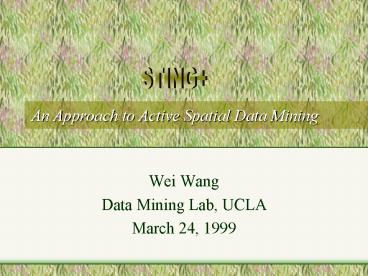An Approach to Active Spatial Data Mining - PowerPoint PPT Presentation
Title:
An Approach to Active Spatial Data Mining
Description:
Conclusions STING+ is an efficient approach to active spatial data mining. Users can define triggers to monitor the change of spatial data. – PowerPoint PPT presentation
Number of Views:147
Avg rating:3.0/5.0
Title: An Approach to Active Spatial Data Mining
1
An Approach to Active Spatial Data Mining
STING
- Wei Wang
- Data Mining Lab, UCLA
- March 24, 1999
2
Outline
- Introduction
- Spatial Data Mining Triggers
- Strategies
- Performance
- Conclusions
3
Introduction
- Huge amount of spatial data are generated
everyday. - Earth Observing System
- National Spatial Data Infrastructure
- National Image Mapping Agency
- one meter resolution data
- digital earth
- Users are usually interested in the hidden
information. - Aggregate information
- Clustering
- Patterns
4
Introduction
- Knowledge discovery processes are computationally
expensive. - Todays technology advances provide necessary
computing power to carry out such complicated
processes.
5
Spatial Data mining Triggers
- Since data evolves over time, interesting
patterns are likely to emerge or change. - Goal identify and find (most of) interesting
patterns - Problems
- Knowledge discovery processes are expensive.
- It is not feasible to re-process the entire
data set for every change. - Approach to periodically examine the data.
- Long delays
- Transient patterns might be missed
- Natural solution Usage of triggers.
6
Spatial Data mining Triggers
- Traditional database triggers can not be directly
applied - Expressive power of traditional database triggers
is limited, especially in describing spatial
relationships. - Example Trigger bandwidth reallocation when the
size of a cluster exceeds 20.
7
Strategies
- STING was designed to introduce and support
spatial triggers efficiently. - Observation (spatial locality) Only objects
added to the shaded area will contribute to the
growth of cluster size at this moment.
8
Strategies
- STING Strategy Monitor only the area occupied
by potential clusters and its neighborhood. - Observation (cumulative effect) at least 4 more
objects are needed in order to make the cluster
size be 20. - STING Strategy Space is organized in a
hierarchy so that updates can be suspended at
some level in the hierarchy until the cumulative
effect might cause the trigger to be fired.
9
Strategies
- Space is recursively divided into smaller
rectangular cells down to a specified granularity
and is organized via the inherit pyramid
hierarchy.
Level 1
10
Strategies
- STING decomposes a trigger into a set of
sub-triggers associated with individual cells in
the hierarchical structure to monitor the
cumulative effect of data changes within the cell.
Sub-trigger on cell
Higher level sub-trigger on cell
11
Strategies
- Updates/insertions are suspended at some level in
the hierarchy until such time that the cumulative
effect of these insertions might cause the
trigger condition to become satisfied.
.
.
.
.
.
.
.
.
.
.
.
.
.
.
.
.
.
.
.
.
.
.
.
.
.
.
.
.
.
.
.
.
.
.
.
.
.
.
.
.
.
.
.
.
.
.
.
.
Level 1
Level 0
12
Strategies
.
.
.
.
.
.
.
.
.
.
.
.
.
.
.
.
.
.
.
.
.
.
.
.
.
.
.
.
.
.
.
.
.
.
.
.
.
.
.
.
.
.
.
.
.
.
.
.
Level 3
Level 2
No update of cluster !
13
Performance
- Comparison with periodic re-examination
- If the period is set to be less than 4000
updates, STING consumes less CPU cycles. - Significant delay and transient patterns misses
can occur for larger period. - Not acceptable in many applications
- No delay and no transient patterns missed with
STING.
14
Conclusions
- STING is an efficient approach to active spatial
data mining. - Users can define triggers to monitor the change
of spatial data. - Updates to the data are carefully monitored
- Evaluation of trigger is postponed until the
cumulative effect of data updates might cause the
trigger to be fired.































